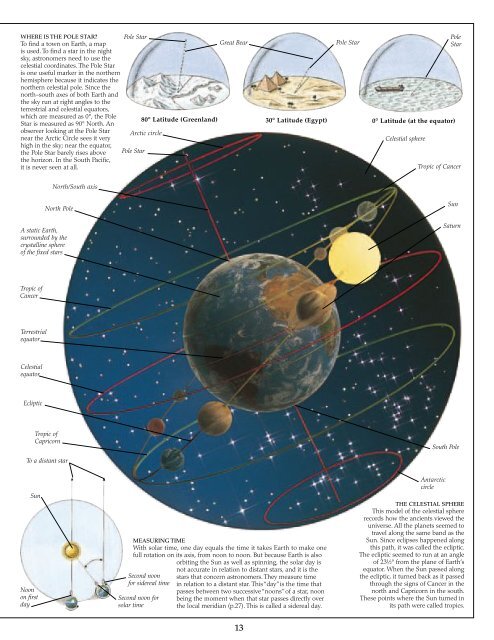DK Eyewitness - Astronomy
Create successful ePaper yourself
Turn your PDF publications into a flip-book with our unique Google optimized e-Paper software.
Where is the pole star? Pole Star<br />
To find a town on Earth, a map<br />
is used. To find a star in the night<br />
sky, astronomers need to use the<br />
celestial coordinates. The Pole Star<br />
is one useful marker in the northern<br />
hemisphere because it indicates the<br />
northern celestial pole. Since the<br />
north–south axes of both Earth and<br />
the sky run at right angles to the<br />
terrestrial and celestial equators,<br />
which are measured as 0°, the Pole<br />
Star is measured as 90° North. An<br />
observer looking at the Pole Star Arctic circle<br />
near the Arctic Circle sees it very<br />
high in the sky; near the equator,<br />
the Pole Star barely rises above Pole Star<br />
the horizon. In the South Pacific,<br />
it is never seen at all.<br />
Great Bear<br />
Pole Star<br />
80° Latitude (Greenland) 30° Latitude (Egypt) 0° Latitude (at the equator)<br />
Celestial sphere<br />
Pole<br />
Star<br />
Tropic of Cancer<br />
North/South axis<br />
North Pole<br />
A static Earth,<br />
surrounded by the<br />
crystalline sphere<br />
of the fixed stars<br />
Sun<br />
Saturn<br />
Tropic of<br />
Cancer<br />
Terrestrial<br />
equator<br />
Celestial<br />
equator<br />
Ecliptic<br />
Tropic of<br />
Capricorn<br />
South Pole<br />
To a distant star<br />
Sun<br />
Noon<br />
on first<br />
day<br />
Measuring time<br />
With solar time, one day equals the time it takes Earth to make one<br />
full rotation on its axis, from noon to noon. But because Earth is also<br />
orbiting the Sun as well as spinning, the solar day is<br />
Second noon<br />
for sidereal time<br />
Second noon for<br />
solar time<br />
not accurate in relation to distant stars, and it is the<br />
stars that concern astronomers. They measure time<br />
in relation to a distant star. This “day” is the time that<br />
passes between two successive “noons” of a star, noon<br />
being the moment when that star passes directly over<br />
the local meridian (p.27). This is called a sidereal day.<br />
Antarctic<br />
circle<br />
The celestial sphere<br />
This model of the celestial sphere<br />
records how the ancients viewed the<br />
universe. All the planets seemed to<br />
travel along the same band as the<br />
Sun. Since eclipses happened along<br />
this path, it was called the ecliptic.<br />
The ecliptic seemed to run at an angle<br />
of 23½° from the plane of Earth’s<br />
equator. When the Sun passed along<br />
the ecliptic, it turned back as it passed<br />
through the signs of Cancer in the<br />
north and Capricorn in the south.<br />
These points where the Sun turned in<br />
its path were called tropics.<br />
13


